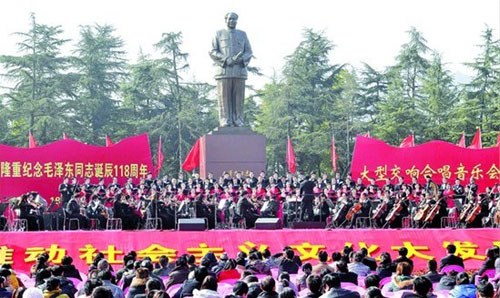
Hunan symphony orchestra performs "East is Red" on Mao's 118th birthday on December 26, 2011. Photo: Courtesy of Shaoshan People's Government
In Chairman Mao Zedong's hometown, a former backwater in Central China's Hunan Province, locals take every worldly precaution to protect the other-worldly life of the Great Helmsman.
When Mao's six-meter statue had to be repositioned in 1993 in the massive square that welcomes millions of pilgrims, locals prayed throughout the night before the move, assuring him that he need not take offence.
Not only were the people of Shaoshan showing great reverence to the "Great Helmsmen," they were ensuring the continuing mystic appeal of Mao, which attracted more than 7 million visitors who spent 1.85 billion yuan ($292.68 million) last year.
The folktales and legends of mysterious happenings here add power to the pull Mao still has on people seeking spiritual guidance and blessings from beyond.
When the torch relay for the 2008 Beijing Olympic Games passed Shaoshan, it's said the sun erupted in a solar corona. When Mao's statue was unveiled almost three decades ago, azaleas on the nearby mountains burst into brilliant bloom months earlier than usual.
Every tour guide and villager in Shaoshan will tell a pumped-up story of a mysterious happening that all will swear to be true.
"It's a unique phenomenon that many Chinese people regard Chairman Mao as a god," Hu Dechang, vice director of Shaoshan Administration Bureau, under the Hunan provincial government, said.
"Numerous coincidences have happened here, especially after the statue was moved in 1993. People still believe that Chairman Mao is up there, watching out for us."
Just about every one of the 1,400 villagers in Shaoshan village is involved in the business of revering Mao more than 30 years after his death, his birthplace has become the epicenter of the "red tourism" industry.
Shaoshan village (old name Shaoshanchong) is administered by Shaoshan, a county-level city with a population of less than 100,000.

Copyright ©1999-2011 Chinanews.com. All rights reserved.
Reproduction in whole or in part without permission is prohibited.